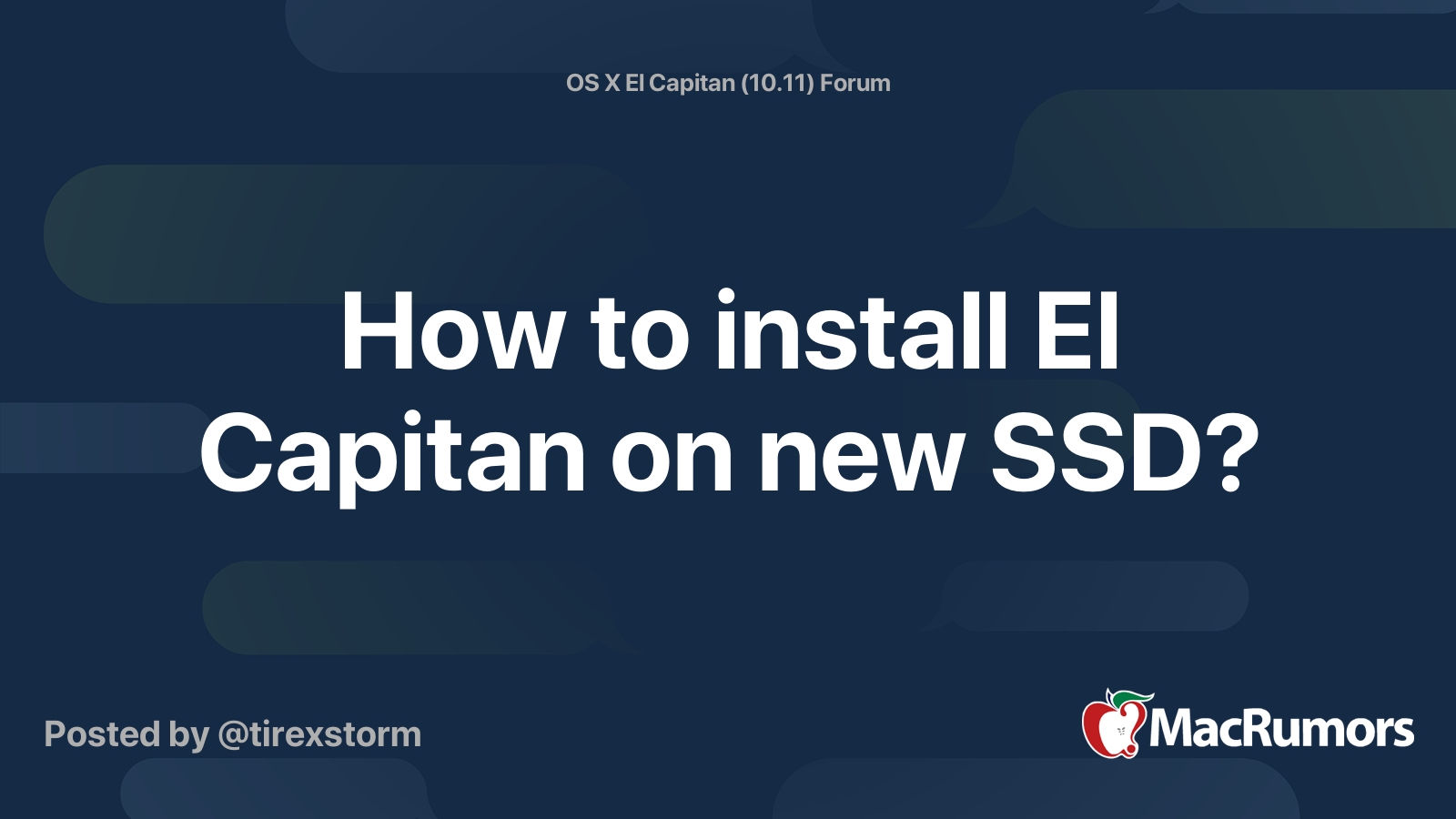- Install El Capitan App
- Install El Capitan On New Ssd Hard Drive
- Install El Capitan On New Ssd Drive
- Mac Os El Capitan Install
Start up from macOS Recovery
Determine whether you're using a Mac with Apple silicon, then follow the appropriate steps:
Once you’ve done that, here’s how to install, reinstall, or upgrade to El Capitan, step by step: Boot from your Recovery HD partition by restarting your Mac while holding down the Command+R keys. The OS X Utilities window appears. Select Reinstall OS X, and click Continue. The OS X El Capitan splash screen appears.

- Had a similar problem when trying to install new ssd 240gb crucial bx500 on macbook 2008 late aluminium. Bootable el capitan usb created using createinstallmedia from a working elcapitan install will not show startup manager. Just a grey screen with a working mouse pointer.
- To install High Sierra, Sierra, El Capitan, Yosemite and earlier: initialise the drive as Mac OS Extended (Journaled) How to get the latest macOS on a new SSD? To reinstall using OS Recovery you need an internet connection, either wireless or ethernet cable.
Apple silicon
Turn on your Mac and continue to press and hold the power button until you see the startup options window. Click the gear icon labeled Options, then click Continue.
Intel processor
Make sure that your Mac has a connection to the internet. Then turn on your Mac and immediately press and hold Command (⌘)-R until you see an Apple logo or other image.
If you're asked to select a user you know the password for, select the user, click Next, then enter their administrator password.
Reinstall macOS
Select Reinstall macOS from the utilities window in macOS Recovery, then click Continue and follow the onscreen instructions.
Follow these guidelines during installation:
- If the installer asks to unlock your disk, enter the password you use to log in to your Mac.
- If the installer doesn't see your disk, or it says that it can't install on your computer or volume, you might need to erase your disk first.
- If the installer offers you the choice between installing on Macintosh HD or Macintosh HD - Data, choose Macintosh HD.
- Allow installation to complete without putting your Mac to sleep or closing its lid. Your Mac might restart and show a progress bar several times, and the screen might be empty for minutes at a time.
After installation is complete, your Mac might restart to a setup assistant. If you're selling, trading in, or giving away your Mac, press Command-Q to quit the assistant without completing setup. Then click Shut Down. When the new owner starts up the Mac, they can use their own information to complete setup.
Other macOS installation options
When you install macOS from Recovery, you get the current version of the most recently installed macOS, with some exceptions:
- On an Intel-based Mac: If you use Shift-Option-Command-R during startup, you're offered the macOS that came with your Mac, or the closest version still available. If you use Option-Command-R during startup, in most cases you're offered the latest macOS that is compatible with your Mac. Otherwise you're offered the macOS that came with your Mac, or the closest version still available.
- If the Mac logic board was just replaced, you may be offered only the latest macOS that is compatible with your Mac. If you just erased your entire startup disk, you may be offered only the macOS that came with your Mac, or the closest version still available.
You can also use these methods to install macOS, if the macOS is compatible with your Mac:
- Use the App Store to download and install the latest macOS.
- Use the App Store or a web browser to download and install an earlier macOS.
- Use a USB flash drive or other secondary volume to create a bootable installer.
After I got my new MBP, I decided to sell my old 2010 MBP. I wanted to keep all my existing data on my old laptop, so I decided to swap out its SSD and to put in a brand new one.
The process of installing Yosemite on the new SSD was not as straightforward as I would have liked. I thought I’d blog about it to help anyone else who needed to do the same.

Install El Capitan App
Basically I was trying to sell a 2010 MBP with a new SSD, with Yosemite installed but not configured.

- Download Yosemite installation from the App store. It might complain that you already have it installed but download it anyway. It will be downloaded to /Applications and be named Install OS X Yosemite.app
- Create a bootable image from the Yosemite installer on a USB stick larger than 6GB. In a terminal run:

Install El Capitan On New Ssd Hard Drive
where MyVolume is the name of your USB stick. Change this to match the name of your USB stick.
- Physically install SSD into the target laptop.
- Insert the Yosemite USB stick into the target laptop and power up. (This might take a while.)
- When the menu finally turns up, choose Disk Utility and format the SSD as Mac OS Extended (Journaled) with a unique name.
- Once complete, exit from Disk Utility and return the main menu.
- Choose to Install OS X on the formatted SSD.
- Follow the prompts until Yosemite is installed.
Install El Capitan On New Ssd Drive
Here’s link to a video on how to physically install the SSD as well as run the software installation.
Mac Os El Capitan Install
If you’d rather install El Capitan on the SSD then follow the How to Install El Capitan on a New SSD guide.